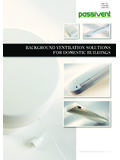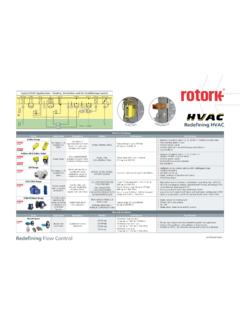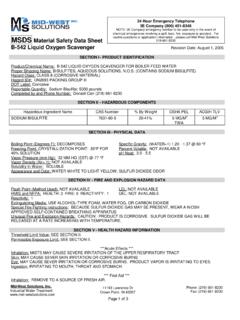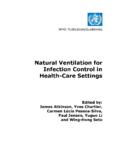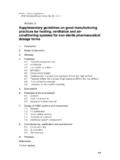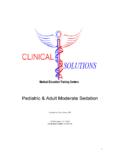Transcription of SAFETY DATA SHEET - Innovative Chemical Solutions | …
1 SAFETY data SHEET1. IdentificationAMPHOSOL CAProduct identifierOther means of identification0214 Product codeSurfactantRecommended useFor industrial use restrictionsManufacturer/Importer/Suppli er/Distributor informationManufacturerStepan CompanyAddress22 West Frontage RoadCompany nameTelephoneGeneral1-847-446-7500 Emergency phone numberMedical1-800-228-5635 Chemtrec1-800-424-9300 Chemtrec Int'l +1 703-527-3887E-mailUSANot , IL 600932. Hazard(s) identificationNot hazardsCategory 1 Serious eye damage/eye irritationHealth hazardsCategory 2 Hazardous to the aquatic environment, acutehazardEnvironmental hazardsCategory 3 Hazardous to the aquatic environment,long-term hazardNot defined hazardsLabel elementsSignal wordDangerHazard statementCauses serious eye damage. Toxic to aquatic life.
2 Harmful to aquatic life with long lasting statementPreventionWear eye/face protection. Avoid release to the in eyes: Rinse cautiously with water for several minutes. Remove contact lenses, if present andeasy to do. Continue rinsing. Immediately call a poison away from incompatible of contents/container in accordance with local/regional/national/international (s) not otherwiseclassified (HNOC)None Composition/information on ingredientsMixturesCAS number% Chemical nameCommon name and synonyms61789-40-0 Cocamidopropyl betaine29 - 317647-14-5 Sodium chloride4 - 61 / 6 Material name: AMPHOSOL CAMaterial ID: 182 Product code: 0214 Version #: 05 Revision date: 06-05-2018 Print date: 06-05-2018 SDS US4. First-aid measuresMove to fresh air. Call a physician if symptoms develop or off with soap and water.
3 Get medical attention if irritation develops and persists. Removeand isolate contaminated clothing and shoes. Wash clothing separately before contactImmediately flush eyes with plenty of water for at least 15 minutes. Remove contact lenses, ifpresent and easy to do. Continue rinsing. Get medical attention contactRinse mouth. Get medical attention if symptoms may include stinging, tearing, redness, swelling, and blurred vision. Permanent eyedamage including blindness could importantsymptoms/effects, acute anddelayedProvide general supportive measures and treat symptomatically. Keep victim under may be of immediatemedical attention and specialtreatment neededEnsure that medical personnel are aware of the material(s) involved, and take precautions toprotect information5.
4 Fire-fighting measuresWater fog. Foam. Dry Chemical powder. Carbon dioxide (CO2).Suitable extinguishing mediaDo not use water jet as an extinguisher, as this will spread the extinguishingmediaDuring fire, gases hazardous to health may be hazards arising fromthe chemicalSelf-contained breathing apparatus and full protective clothing must be worn in case of protective equipmentand precautions for firefightersMove containers from fire area if you can do so without fightingequipment/instructionsUse standard firefighting procedures and consider the hazards of other involved methodsNo unusual fire or explosion hazards fire hazards6. Accidental release measuresKeep unnecessary personnel away. Keep people away from and upwind of spill/leak. Keep out oflow areas. Wear appropriate protective equipment and clothing during clean-up.
5 Do not touchdamaged containers or spilled material unless wearing appropriate protective clothing. Ensureadequate ventilation . Local authorities should be advised if significant spillages cannot precautions,protective equipment andemergency proceduresLarge Spills: Stop the flow of material, if this is without risk. Dike the spilled material, where this ispossible. Cover with plastic SHEET to prevent spreading. Absorb in vermiculite, dry sand or earthand place into containers. Prevent entry into waterways, sewer, basements or confined product recovery, flush area with Spills: Wipe up with absorbent material ( cloth, fleece). Clean surface thoroughly toremove residual return spills to original containers for and materials forcontainment and cleaning upAvoid release to the environment.
6 Contact local authorities in case of spillage to drain/aquaticenvironment. Prevent further leakage or spillage if safe to do so. Do not contaminate water. Avoiddischarge into drains, water courses or onto the precautions7. Handling and storageDo not get this material in contact with eyes. Avoid prolonged exposure. Provide adequateventilation. Wear appropriate personal protective equipment. Observe good industrial hygienepractices. Avoid release to the environment. Do not empty into for safe handlingStore in original tightly closed for safe storage,including any incompatibilities8. Exposure controls/personal protectionNo biological exposure limits noted for the ingredient(s).Biological limit values2 / 6 Material name: AMPHOSOL CAMaterial ID: 182 Product code: 0214 Version #: 05 Revision date: 06-05-2018 Print date: 06-05-2018 SDS USGood general ventilation (typically 10 air changes per hour) should be used.
7 ventilation ratesshould be matched to conditions. If applicable, use process enclosures, local exhaust ventilation ,or other engineering controls to maintain airborne levels below recommended exposure limits. Ifexposure limits have not been established, maintain airborne levels to an acceptable level. Provideeyewash station. Eye wash facilities and emergency shower must be available when handling engineeringcontrolsIndividual protection measures, such as personal protective equipmentWear SAFETY glasses with side shields (or goggles) and a face protectionSkin protectionWear protective protectionWear appropriate Chemical resistant case of insufficient ventilation , wear suitable respiratory protectionWear appropriate thermal protective clothing, when hazardsAlways observe good personal hygiene measures, such as washing after handling the materialand before eating, drinking, and/or smoking.
8 Routinely wash work clothing and protectiveequipment to remove hygieneconsiderations9. Physical and Chemical thresholdNot - 7 (10% in water)Melting point/freezing F (-8 C)Initial boiling point and boilingrange> 212 F (> 100 C)Flash point> F (> C) Pensky-Martens Closed CupEvaporation rateNot (solid, gas)Upper/lower flammability or explosive limitsFlammability limit - lower(%)Not limit - upper(%)Not limit - lower (%)Not limit - upper (%)Not pressureNot densityNot densityNot (ies)Solubility (water)Not temperatureNot temperatureNot cP @ 25 COther lb/gal @ 25 CPercent volatile60 - 66 %Pour point23 F (-5 C)10. Stability and reactivityThe product is stable and non-reactive under normal conditions of use, storage and is stable under normal stability3 / 6 Material name: AMPHOSOL CAMaterial ID: 182 Product code: 0214 Version #: 05 Revision date: 06-05-2018 Print date: 06-05-2018 SDS USNo dangerous reaction known under conditions of normal of hazardousreactionsAvoid temperatures exceeding the flash point.
9 Contact with incompatible to avoidStrong oxidizing materialsNo hazardous decomposition products are decompositionproducts11. Toxicological informationInformation on likely routes of exposureInhalationProlonged inhalation may be contactNo adverse effects due to skin contact are contactCauses serious eye to be a low ingestion related to thephysical, Chemical andtoxicological characteristicsSymptoms may include stinging, tearing, redness, swelling, and blurred vision. Permanent eyedamage including blindness could on toxicological effectsAcute toxicityTest ResultsProductSpeciesAMPHOSOL CADermalAcuteLD50 Rabbit> 2000 mg/kgOralLD50 Rat2335 mg/kgProlonged skin contact may cause temporary corrosion/irritationCauses serious eye eye damage/eyeirritationRespiratory or skin sensitizationRespiratory sensitizationNot product is not expected to cause skin sensitizationNo data available to indicate product or any components present at greater than aremutagenic or cell mutagenicityCarcinogenicityThis product is not considered to be a carcinogen by IARC, ACGIH, NTP, or Monographs.
10 Overall Evaluation of CarcinogenicityNot Specifically Regulated Substances (29 CFR )Not National Toxicology Program (NTP) Report on CarcinogensNot product is not expected to cause reproductive or developmental toxicitySpecific target organ toxicity -single exposureNot target organ toxicity -repeated exposureNot hazardNot effectsProlonged inhalation may be Ecological informationToxic to aquatic life. Harmful to aquatic life with long lasting and degradabilityNo data potentialNo data in soil4 / 6 Material name: AMPHOSOL CAMaterial ID: 182 Product code: 0214 Version #: 05 Revision date: 06-05-2018 Print date: 06-05-2018 SDS USOther adverse effectsNo other adverse environmental effects ( ozone depletion, photochemical ozone creationpotential, endocrine disruption, global warming potential) are expected from this Disposal considerationsDispose of contents/container in accordance with local/regional/national/international instructionsThe waste code should be assigned in discussion between the user, the producer and the wastedisposal waste codeDispose of in accordance with local regulations.










